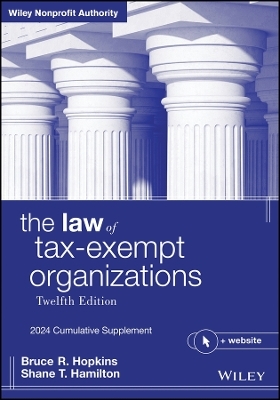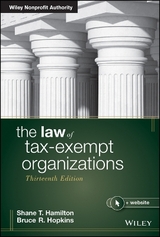
The Law of Tax-Exempt Organizations
John Wiley & Sons Inc (Verlag)
978-1-394-22341-1 (ISBN)
- Titel erscheint in neuer Auflage
- Artikel merken
In the 2024 Cumulative Supplement to The Law of Tax-Exempt Organizations, 12th Edition, a team of experienced and renowned attorneys delivers the latest developments in the ever-evolving tangle of laws and regulations impacting on the operation of tax-exempt entities in the United States. You’ll find discussions of the most recent Treasury Department regulations, Internal Revenue Service revenue rulings and revenue procedures, and federal court opinions (and the occasional state court opinion of particular importance) from 2023 and 2024.
The authors explore new private letter rulings from the IRS, updating the public on their position on a wide array of issues with day-to-day applicability to tax exempt organizations. You’ll also find:
Incisive and authoritative analysis of recent federal court decisions impacting the managers, officers, and directors of tax-exempt organizations
The authors’ valuable insights into the efficacy and correctness of the various rulings, procedures, and opinions from government agencies issued since 2023
Careful consideration of the effect of the growing number of laws, regulations, and procedures impacting the management of tax-exempt entities
Perfect for the managers, directors, and officers of tax-exempt organizations, the 2024 Cumulative Supplement to the 12th edition of The Law of Tax-Exempt Organizations will also prove invaluable to the lawyers, accountants, and other professionals who serve them.
Bruce R. Hopkins (Kansas City, MO) practiced nonprofit law, as he worked with and advised tax-exempt and charitable organizations. He began practicing, studying and writing about the field of nonprofit following the passage of the first U.S. Congressional bill, passed in 1969, that established nonprofit and tax-exempt organizations in the United States of America. As a practicing attorney, professor, mentor and scholar in the field, Bruce was often referred to as the "Dean of Nonprofit Law." He was a presenter and featured speaker, nationally and internationally, at numerous conferences throughout his career, among them Representing and Managing Tax-Exempt Organizations (Georgetown University Law Center, Washington, D.C.) and The Private Foundations Tax Seminar (El Pomar Foundation, Colorado Springs, CO). He practiced law in Washington, D.C. and Kansas City, MO, for over 50 years, receiving numerous awards and forms of recognition for his efforts. Shane Hamilton (Coppell, TX) has represented tax-exempt, nonprofit organizations in connection with their federal tax and nonprofit governance matters for over two decades, including family- and company-sponsored private foundations, publicly supported charities, private schools, churches and religious organizations, supporting organizations, charitable trusts, social welfare organizations, and trade associations. He regularly counsels tax-exempt organizations on a wide range of matters involving nonprofit corporate law, governance best practices, obtaining and maintaining federal tax-exempt status, UBIT, excess benefit transactions (intermediate sanctions), private foundation excise taxes, and other legal requirements applicable to tax-exempt organizations. In addition to advising tax-exempt clients on their tax and legal issues, he offers clients practical advice on navigating the challenges presented when business or mission-oriented goals conflict with the tax laws. Over the years, Mr. Hamilton has acted as outside general counsel for many different organizations; currently he serves in that role for The Meadows Mental Health Policy Institute for Texas.
A Letter to the Reader xv
About the Authors xvii
Preface xix
About the Online Resources xxiii
Book Citations xxv
Part One: Introduction to the Law Of Tax-exempt Organizations
1 Definition of and Rationales for Tax-Exempt Organizations 3
§ 1.1 Definition of Nonprofit Organization 3
§ 1.2 Definition of Tax-Exempt Organization 4
§ 1.4 Political Philosophy Rationale 4
2 Overview of Nonprofit Sector and Tax-Exempt Organizations 7
§ 2.1 Profile of Nonprofit Sector 7
§ 2.2 Organization of IRS 9
Part Two: Fundamentals of the Law of Tax-exempt Organizations
3 Tax Exemption: Source and Recognition 15
§ 3.2 Recognition of Tax Exemption 15
§ 3.3 Recognition of Public Charity, Private Foundation Status 15
§ 3.4 Alternatives to Tax-Exempt Status 16
4 Organizational, Operational, and Related Tests and Doctrines 19
§ 4.1 Forms of Tax-Exempt Organizations 19
§ 4.3 Organizational Test 19
§ 4.4 Primary Purpose Test 21
§ 4.5 Operational Test 22
§ 4.6 Exclusively Standard 22
§ 4.7 Commensurate Test 22
§ 4.8 State Action Doctrine 23
§ 4.9 Commerciality Doctrine 23
5 Nonprofit Governance 27
§ 5.3 Board Duties and Responsibilities 27
§ 5.7 IRS and Governance 29
Part Three: Tax-exempt Charitable Organizations
6 Concept of Charitable 33
§ 6.2 Public Policy Doctrine 33
§ 6.3 Collateral Concepts 34
7 Charitable Organizations 37
§ 7.2 Relief of Distressed 37
§ 7.3 Credit Counseling 42
§ 7.4 Provision of Housing 42
§ 7.6 Promotion of Health 43
§ 7.7 Lessening Burdens of Government 44
§ 7.8 Advancement of Education 45
§ 7.10 Advancement of Religion 46
§ 7.11 Promotion of Social Welfare 46
§ 7.14 Fundraising Organizations 46
§ 7.15 Instrumentalities of Government 47
§ 7.16 Other Categories of Charity 47
§ 7.17 Qualified Opportunity Zones 48
8 Educational Organizations 51
§ 8.3 Educational Institutions 51
§ 8.4 Instruction of Individuals 52
§ 8.5 Instruction of Public 52
9 Scientific Organizations 55
§ 9.2 Concept of Research 55
§ 9.4 Scientific as Charitable or Educational 56
10 Religious Organizations 57
§ 10.1 Constitutional Law Framework 57
§ 10.2 Federal Tax Law Definition of Religion 58
§ 10.3 Churches and Similar Institutions 58
§ 10.5 Integrated Auxiliaries of Churches 58
§ 10.7 Religious Orders 58
11 Other Types of Charitable Organizations 61
§ 11.2 Amateur Sports Organizations 61
§ 11.8 Donor-Advised Funds 61
§ 11.9 Endowment Funds 66
12 Public Charities and Private Foundations 71
§ 12.1 Federal Tax Law Definition of Private Foundation 71
§ 12.3 Categories of Public Charities 71
§ 12.4 Private Foundation Rules 77
Part Four: other Tax-exempt Organizations
13 Social Welfare Organizations 81
§ 13.1 Concept of Social Welfare 81
§ 13.3 Conduct of Business 82
§ 13.4 Advocacy Organizations 82
14 Business Leagues and Similar Organizations 83
§ 14.1 Concept of Business League 83
§ 14.2 Disqualifying Activities 84
15 Social Clubs 87
§ 15.1 Social Clubs in General 87
§ 15.3 Investment Income Limitation 88
§ 15.4 Exceptions to Limitations 88
§ 15.5 Taxation of Social Clubs 88
16 Labor, Agricultural, and Horticultural Organizations 91
§ 16.1 Labor Organizations 91
§ 16.2 Agricultural Organizations 91
17 Political Organizations 93
§ 17.4 Public Policy Advocacy Activities 93
§ 17.5 Taxation of Political Organizations 93
18 Employee Benefit Funds 95
§ 18.3 Voluntary Employees’ Beneficiary Associations 95
19 Other Categories of Tax-Exempt Organizations 97
§ 19.4 Fraternal Organizations 97
§ 19.6 Cemetery Companies 98
§ 19.9 Insurance Companies and Associations 98
§ 19.11 Veterans’ Organizations 98
§ 19.12 Farmers’ Cooperatives 98
§ 19.14 Homeowners’ Associations 98
§ 19.18 Qualified Health Insurance Issuers 98
§ 19.19 Qualified Tuition Programs 99
§ 19.20 ABLE Programs 99
§ 19.21 Professional Sports Leagues 100
§ 19.22 Governmental and Quasi-Governmental Entities 100
§ 19.24 Other Categories of Tax-Exempt Organizations 101
Part Five: Principal Exempt Organization Laws
20 Private Inurement and Private Benefit Doctrines 105
§ 20.4 Compensation Issues 105
§ 20.5 Executive Compensation Tax 106
§ 20.6 Other Forms of Private Inurement 111
§ 20.10 Private Inurement and Business Leagues 114
§ 20.12 Private Inurement and Other Categories of Exempt Organizations 114
§ 20.13 Private Benefit Doctrine 115
21 Intermediate Sanctions 119
§ 21.3 Disqualified Persons 119
§ 21.4 Transactions Involved 119
§ 21.14 Return for Payment of Excise Taxes 120
§ 21.16 Interrelationship with Private Inurement Doctrine 121
22 Legislative Activities by Tax-Exempt Organizations 123
§ 22.3 Lobbying by Charitable Organizations 123
§ 22.6 Legislative Activities of Business Leagues 124
23 Political Campaign Activities by Tax-Exempt Organizations 125
§ 23.2 Prohibition on Charitable Organizations 125
§ 23.3 Political Campaign Expenditures and Tax Sanctions 125
§ 23.6 Political Activities of Social Welfare Organizations 125
24 Unrelated Business: Basic Rules 127
§ 24.1 Introduction to Unrelated Business Rules 127
§ 24.2 Definition of Trade or Business 127
§ 24.3 Definition of Regularly Carried On 128
§ 24.4A Deemed Unrelated Business Income 128
§ 24.5 Contemporary Applications of Unrelated Business Rules 128
§ 24.9 Unrelated Debt-Financed Income 129
25 Unrelated Business: Modifications, Exceptions, Special Rules, and Taxation 133
§ 25.1 Modifications 133
§ 25.2 Exceptions 135
§ 25.3 Special Rules 137
§ 25.4 Fringe Benefit Rules 137
§ 25.5 “Bucketing” Rule 138
§ 25.7 Deduction Rules 143
Part Six: Acquisition and Maintenance Of Tax Exemption
26 Exemption Recognition and Notice Processes 149
§ 26.1 Recognition Application Procedure 149
§ 26.2 Requirements for Charitable Organizations 156
§ 26.3 Nonprivate Foundation Status 156
§ 26.4 Requirements for Social Welfare Organizations 157
§ 26.8 Requirements for Certain Health Insurance Issuers 157
§ 26.10 Rules for other Categories of Organizations 157
§ 26.10A Withdrawal of Request for Determination Letter 158
§ 26.11 Group Exemption Rules 158
§ 26.13 Notice Requirements for Social Welfare Organizations 163
§ 26.14 Notice Requirements for Political Organizations 164
§ 26.16 Forfeiture of Tax Exemption 164
§ 26.17 Constitutional Law Aspects of Process 165
27 Administrative and Litigation Procedures 167
§ 27.1 Administrative Procedures Where Recognition Denied 167
§ 27.2 Revocation or Modification of Tax-Exempt Status: Administrative Procedures 169
§ 27.3 Retroactive Revocation of Tax-Exempt Status 169
§ 27.3A Tax Consequences of Retroactive Revocation of Exempt Status of Public Charities 170
§ 27.4 Statute of Limitations Matters 175
§ 27.5 Revocation of Tax-Exempt Status: Litigation Procedures 175
§ 27.6 IRS Examination Procedures and Practices 179
§ 27.9 IRS Disclosure to State Officials 185
28 Operational Requirements 187
§ 28.1 Changes in Operations or Form 187
§ 28.2 Annual Reporting Rules 190
§ 28.3 Notification Requirement 195
§ 28.5 Filing Requirements and Tax-Exempt Status 195
§ 28.7 Reporting by Political Organizations 196
§ 28.8 Electronic Filing Rules 196
§ 28.9 Unrelated Business Income Tax Returns 197
§ 28.10 IRS Document Disclosure Rules 200
§ 28.11 Document Disclosure Obligations of Exempt Organizations 200
§ 28.14 Insurance Activities 206
§ 28.17 Tax-Exempt Organizations and Tax Shelters 207
§ 28.17 International Grantmaking Requirements 207
§ 28.18 Recordkeeping Requirements 208
28A Tax-Exempt Organizations and Tax Shelters 209
§ 28A.1 Concept of Tax Shelter 210
§ 28A.2 Judicial Doctrines 211
§ 28A.3 Tax Shelter Law in General 215
§ 28A.4 Exempt Organizations and Tax Shelter Penalties 221
§ 28A.5 Exempt Organizations’ Involvement in Shelters 223
§ 28A.6 GAO Findings and Recommendations 236
§ 28A.7 “Dirty Dozen” Listings 238
Part Seven: Interorganizational Structures And Operational Forms
29 Tax-Exempt Organizations and Exempt Subsidiaries 241
§ 29.2 Charitable Organizations as Subsidiaries 241
§ 29.3 Tax-Exempt Subsidiaries of Charitable Organizations 241
§ 29.7 Revenue From Tax-Exempt Subsidiary 241
30 Tax-Exempt Organizations and for-Profit Subsidiaries 243
§ 30.2 Potential of Attribution to Parent 243
31 Tax-Exempt Organizations and Joint Ventures 245
§ 31.1 Partnerships and Joint Venture Basics 245
§ 31.3 Whole-Entity Joint Ventures 245
§ 31.4 Ancillary Joint Ventures 245
32 Tax-Exempt Organizations: Other Operations and Restructuring 247
§ 32.1 Mergers 247
§ 32.6 Conversion From Exempt to Nonexempt Status 247
§ 32.7 Conversion From Nonexempt to Exempt Status 247
§ 32.8 Conversion from One Exempt Status to Another 251
Index 253
| Erscheinungsdatum | 23.04.2024 |
|---|---|
| Verlagsort | New York |
| Sprache | englisch |
| Maße | 178 x 254 mm |
| Gewicht | 454 g |
| Themenwelt | Wirtschaft ► Betriebswirtschaft / Management ► Planung / Organisation |
| ISBN-10 | 1-394-22341-2 / 1394223412 |
| ISBN-13 | 978-1-394-22341-1 / 9781394223411 |
| Zustand | Neuware |
| Haben Sie eine Frage zum Produkt? |
aus dem Bereich



